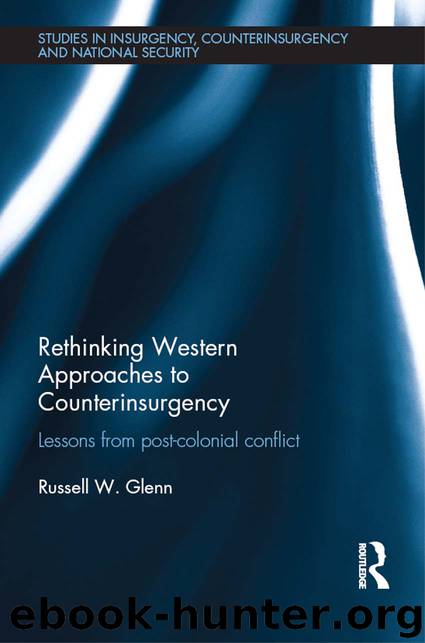Rethinking Western Approaches to Counterinsurgency by Glenn Russell W

Author:Glenn, Russell W.
Language: eng
Format: epub
ISBN: 978-1-317-59276-1
Publisher: Taylor and Francis
Considering the nature of Solomon Islands insurgency
There was no provision of services. … Politicians were aligning themselves with criminal gangs. … No effective opposition. … What there was is a group of individuals who would buy votes. … There was no effective government that you would mount an insurgency against. There were just these groups that were fighting over land, over money. It wasn’t as cohesive as I would imagine an insurgency to be, to destabilize a government. … I don’t think any of them had a long-term strategy; everybody was living day-to-day for everything they could get for themselves.22
Did the Regional Assistance Mission to Solomon Islands confront what we can legitimately consider an insurgency? Ben McDevitt’s statement just above implies he had reservations in that regard given that there was no effective government to undermine and the “insurgents” seemed to have little in the way of objectives. His point is a valid one. Our definition of insurgency, like virtually any other, requires the existence of a government. The absence of such an authority makes insurgency impossible. Yet there remained sufficient government to cry for help even as anarchy chased reason to the cliff’s edge in Solomon Islands. Harold Keke’s Guadalcanal Liberation Front and other militias controlled territory and segments of the Solomon Islands’ population, denying entry to, even slaying Honiara’s representatives sent to force their return to the fold. The GLF was among those undermining the sovereign authority of the standing government, albeit a weak and largely ineffective authority in the months before RAMSI’s arrival.
Lieutenant Colonel Frewen took a somewhat different viewpoint than that of his colleague McDevitt. In Frewen’s mind the threat to the Solomon Islands’ peace and stability – and the remnants of national government – was a criminal insurgency. Rather than seeking to undermine or overthrow the government in Honiara, militias and corrupt politicians (sometimes associated with those militias) sought to deny any authorities that might be so inclined the capability to interfere with illegal access to the country’s resources. Control of territory or population was less important than precluding the government’s ability to impede that access. New Zealand’s Peter Noble served in Solomon Islands with the International Peace Monitoring Team in 2001. Noble similarly argued that what confronted RAMSI and the government in Honiara was not “an insurgency as you and I would understand it.” While there were various groups “sucking the blood out of the state,” the behavior of the leaders and members of some militia groups was more “criminal or psychopathic” in character than oriented toward objectives that would fit traditional definitions of insurgency.23 The observations by Frewen and Noble are important ones; they once again emphasize the unimportance of motivation in determining the existence of an insurgency. Whether politically, criminally, or otherwise driven, Harold Keke’s GLF controlled portions of the Weathercoast and segments of the population there. Other militia groups subverted the government’s ability to maintain the rule of law. (So too did many of the politicians within the government, though there
Download
This site does not store any files on its server. We only index and link to content provided by other sites. Please contact the content providers to delete copyright contents if any and email us, we'll remove relevant links or contents immediately.
| Automotive | Engineering |
| Transportation |
Whiskies Galore by Ian Buxton(41935)
Introduction to Aircraft Design (Cambridge Aerospace Series) by John P. Fielding(33085)
Small Unmanned Fixed-wing Aircraft Design by Andrew J. Keane Andras Sobester James P. Scanlan & András Sóbester & James P. Scanlan(32763)
Craft Beer for the Homebrewer by Michael Agnew(18193)
Turbulence by E. J. Noyes(7977)
The Complete Stick Figure Physics Tutorials by Allen Sarah(7334)
Kaplan MCAT General Chemistry Review by Kaplan(6896)
The Thirst by Nesbo Jo(6876)
Bad Blood by John Carreyrou(6580)
Modelling of Convective Heat and Mass Transfer in Rotating Flows by Igor V. Shevchuk(6406)
Learning SQL by Alan Beaulieu(6235)
Weapons of Math Destruction by Cathy O'Neil(6205)
Man-made Catastrophes and Risk Information Concealment by Dmitry Chernov & Didier Sornette(5951)
Digital Minimalism by Cal Newport;(5698)
Life 3.0: Being Human in the Age of Artificial Intelligence by Tegmark Max(5506)
iGen by Jean M. Twenge(5384)
Secrets of Antigravity Propulsion: Tesla, UFOs, and Classified Aerospace Technology by Ph.D. Paul A. Laviolette(5330)
Design of Trajectory Optimization Approach for Space Maneuver Vehicle Skip Entry Problems by Runqi Chai & Al Savvaris & Antonios Tsourdos & Senchun Chai(5036)
Pale Blue Dot by Carl Sagan(4947)
